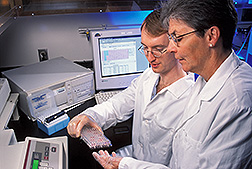This page has been archived and is being provided for reference purposes only. The page is no longer being updated, and therefore, links on the page may be invalid.
Read the magazine story to find out more. |
|
Discovering More About Healthy Bones
By Marcia WoodJanuary 12, 2005
Many people can improve their bone health by doing weight-bearing exercise like walking or jogging, and by eating foods rich in calcium. But scientists such as Marta D. Van Loan, a research physiologist with the Agricultural Research Service, are intent on discovering more details about exactly how our eating patterns and exercise habits affect our bones.
Van Loan's research at the ARS Western Human Nutrition Research Center at Davis, Calif., may help prevent osteoporosis, a thinning and weakening of bones. Today, osteoporosis afflicts an estimated 10 million Americans.
In one current study, Van Loan and colleagues at Iowa State University are looking at how soy supplements affect the bones of more than 200 healthy, post-menopausal women.
An earlier investigation focused on healthy women in their early 20s. Van Loan and co-researchers found that volunteers who had spent fewer hours watching television or videos in their pre-teen years—when our bodies are still forming new bone—had a better bone-health score when they reached their 20s than did volunteers who spent longer hours in front of the TV set.
That finding, reported in a 2003 issue of the American Journal of Clinical Nutrition, agreed with those of other studies, done elsewhere, and helped underscore the importance of regular exercise.
In addition, analyses of the volunteers' eating habits indicated that those who consumed a daily average of more than 1,000 mg of calcium from food (the amount in about 6.5 slices of American cheese) during mid-puberty had a better bone-mass score as a young adult than did those women who had consumed less than 1,000 mg of this essential mineral.
Van Loan collaborated in the investigation with Patricia B. Crawford, Mark Hudes and Kirsten Shimmering of the University of California at Berkeley, and Laura K. Bachrach of Stanford University, who led the research.
Read more about the research in the January issue of Agricultural Research magazine.
ARS is the U.S. Department of Agriculture's chief scientific research agency.


